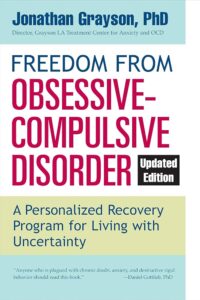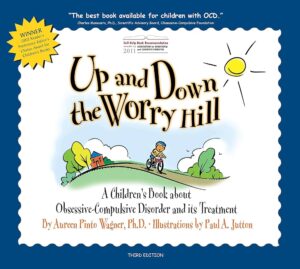Books for OCD: Recommendations by a Psychologist
As a psychologist specializing in OCD treatment for teens and young adults, I’m often asked about the best books for understanding and managing OCD. While professional treatment is crucial, the right resources can offer essential education to the newly diagnosed, and reinforce the learning of those already engaged in treatment. Here are my top 10 book recommendations.
Best for Understanding OCD Basics: “Brain Lock” by Jeffrey M. Schwartz

“Brain Lock” is an excellent starting point if you’re newly diagnosed with OCD, or looking for an overview of the disorder and treatment. Dr. Schwartz offers a clear explanation of OCD, helping readers understand the cycle of obsessions, anxiety, and compulsions that characterize the disorder. A four-step method for self-treatment empowers individuals to take an active role in their recovery. By combining mindfulness techniques with cognitive behavioral therapy (CBT) principles, Dr. Schwartz provides strategies to disrupt the OCD cycle and reduce the anxiety that often drives compulsive behaviors. This book is particularly valuable for those just beginning to grapple with their OCD symptoms and seeking a foundational understanding of the condition.
Best Workbook: “The OCD Workbook” by Bruce M. Hyman and Cherlene Pedrick

For those who prefer a hands-on approach, this comprehensive workbook is like having a therapist’s guidance at your fingertips. It covers everything from identifying triggers to implementing exposure and response prevention (ERP) – a key component in OCD treatment. I often recommend this to my clients who appreciate interactive learning and practical exercises.
Best for Mindfulness Techniques: “The Mindfulness Workbook for OCD” by Jon Hershfield and Tom Corboy

Mindfulness can be a powerful tool in managing OCD symptoms, and this workbook brilliantly blends these practices with cognitive behavioral therapy (CBT). In my practice, I’ve seen how this combination helps clients develop a new relationship with their thoughts and feelings.
What I particularly love about this workbook is its practical approach to various OCD subtypes – from contamination fears to intrusive thoughts. Through clear exercises and relatable examples, readers learn to observe their thoughts without judgment and reduce the power of obsessions. The authors’ warm, accessible style makes complex concepts manageable, and the step-by-step guidance empowers readers to take an active role in their recovery.
Best for Learning Acceptance Techniques: “Living Beyond OCD Using Acceptance and Commitment Therapy” by Patricia E. Zurita Ona

Clients benefit from learning different approaches to managing OCD. This book introduces Acceptance and Commitment Therapy (ACT), an evidence-based approach that teaches us to accept difficult thoughts and feelings while focusing on the actions that matter to us.
ACT for OCD shifts the focus from battling symptoms to building a meaningful life. Dr. Zurita Ona provides practical exercises that help readers develop psychological flexibility, a crucial skill for long-term OCD management. I’ve seen clients particularly benefit from these strategies, especially those feeling stuck in their recovery journey. It’s an excellent complement to traditional treatments like ERP.
Best for Parents: “Freeing Your Child from Obsessive-Compulsive Disorder” by Tamar E. Chansky

As someone who works extensively with families in my Brooklyn practice, I often recommend this compassionate and practical guide to parents. Dr. Chansky’s book feels like having a knowledgeable, understanding friend walk you through the complexities of childhood OCD, helping parents move from feeling helpless to becoming confident advocates for their child’s recovery.
The book breaks down complex concepts into manageable strategies that work in real-world situations – from morning routines to bedtime struggles. What I particularly like is its emphasis on the whole family’s wellbeing, acknowledging that supporting a child with OCD affects everyone in the household. This is a resource I find myself returning to again and again, especially when helping parents understand their crucial role in their child’s treatment journey.
Best for Exposure and Response Prevention (ERP) Therapy: “Stop Obsessing!” by Edna B. Foa and Reid Wilson

ERP is a gold-standard treatment for OCD, and this book makes these powerful techniques accessible for daily life. As someone who uses ERP extensively in my practice, I appreciate how Drs. Foa and Wilson break down this complex approach into manageable steps.
What makes this book particularly valuable is its practical guidance for gradually facing fears while reducing compulsive behaviors. I often recommend it to clients starting ERP therapy, as it perfectly complements our in-session work. The authors’ clear explanations and real-life examples help readers understand both the “why” and “how” of exposure therapy. The troubleshooting tips and exercises are especially helpful between sessions, making it an invaluable resource for anyone on their OCD recovery journey.
Best Comprehensive Guide: “Freedom from Obsessive Compulsive Disorder” by Jonathan Grayson

With over 35 years of experience treating OCD, Dr. Grayson offers what I consider the most comprehensive guide for understanding and managing this condition. What makes this book exceptional is how it combines deep clinical expertise with genuine compassion and practical wisdom.
I especially value how Dr. Grayson addresses one of OCD’s core challenges: the need for certainty. Through detailed case studies and clear explanations, he helps readers understand why seeking absolute certainty actually maintains OCD cycles. His approach to embracing uncertainty while using Exposure and Response Prevention (ERP) has been transformative for many of my clients. The personal stories throughout the book help readers feel less alone and more hopeful about their recovery journey.
Best for Teens: “The OCD Workbook for Teens” by Jon Hershfield

In my work with teenagers, I’ve found this workbook to be an invaluable resource that truly speaks to their experiences. Hershfield has a remarkable ability to connect with young readers, breaking down complex OCD concepts into language and examples that resonate with teen life – from social media anxiety to academic pressures.
What I particularly value about this workbook is how it balances being informative with staying engaging. The interactive exercises are designed to fit into a busy student’s schedule, and the emphasis on building self-compassion really helps teens feel less alone. I often recommend this to my younger clients as a between-sessions companion, helping them develop practical skills while maintaining their sense of independence and control in their treatment journey.
Best for Children: “Up and Down the Worry Hill” by Aureen Pinto Wagner

As someone who works extensively with families affected by OCD, I often recommend this thoughtfully crafted book to help children understand and cope with their symptoms. Dr. Wagner uses the metaphor of climbing a hill to explain the challenges and victories in managing OCD – a concept that resonates deeply with young minds. Through the story of Casey, children learn that while going “up the worry hill” might feel scary, coming down the other side brings relief and accomplishment.
The book introduces key therapeutic concepts like Exposure and Response Prevention (ERP) in child-friendly language, making it an invaluable tool for children ages 6-12 and their parents. I’ve seen firsthand how this metaphor helps children better understand their treatment journey and feel more empowered in facing their fears.
Best for Quick Reference:“The OCD Answer Book” by Patrick B. McGrath

Sometimes, you just need a quick answer to a specific question. This book serves as an excellent quick-reference guide to common OCD questions and concerns. It’s a resource I often recommend to clients who want easily accessible information between our sessions.
Favorite quote: “The goal of therapy is to break the link between the thoughts and behaviors, getting people to recognize that just because you think something does not mean it is true and that you need to do something to undo the thought”
Frequently Asked Questions About OCD Books
As a psychologist specializing in OCD treatment, I often receive questions about using self-help books for managing OCD symptoms. Here are some of the most common questions I encounter, along with my professional insights:
Can reading these books cure my OCD?
While these books are valuable resources, they’re not intended to “cure” OCD on their own. OCD is a complex condition that typically requires professional treatment. However, these books can be excellent supplements to therapy, providing education, coping strategies, and exercises that support your overall treatment plan.
How do I know which book to start with?
If you’re new to learning about OCD, I usually recommend starting with “Brain Lock” by Jeffrey M. Schwartz or “The OCD Workbook” by Bruce M. Hyman and Cherlene Pedrick. These provide a solid foundation for understanding OCD and offer practical strategies. However, the best starting point can vary based on your specific symptoms and needs. When in doubt, consult with a mental health professional for personalized recommendations.
How long will it take to see results from using these books?
The timeline for improvement can vary greatly from person to person. Some individuals may notice small changes in their thinking or behavior within a few weeks of consistently applying the techniques in these books. However, significant and lasting improvement often takes months of dedicated practice. Remember, managing OCD is a journey, not a quick fix.
Can these books replace therapy?
While these books are excellent resources, they’re not designed to replace professional therapy. OCD treatment often requires personalized guidance, especially when it comes to techniques like Exposure and Response Prevention (ERP). These books work best when used in conjunction with professional treatment.
What if I start feeling worse while reading these books?
It’s not uncommon to experience temporary increases in anxiety when first confronting OCD symptoms. If you find your symptoms worsening significantly or persistently, it’s important to reach out to a mental health professional. They can provide support and ensure you’re applying the techniques in a way that’s helpful for your specific situation.
Are these books helpful for family members of someone with OCD?
Absolutely! Books like “Loving Someone with OCD” are specifically designed for family members and loved ones. Even the other books can provide valuable insights into OCD, helping family members better understand and support their loved one’s journey.
How can I make the most of these books?
To get the most benefit, I recommend:
- Reading actively: Take notes, highlight important passages, and really engage with the material.
- Practice regularly: Many of these books include exercises. Commit to practicing these consistently.
- Be patient with yourself: Change takes time. Celebrate small victories along the way.
- Discuss with a professional: If you’re in therapy, bring the books to your sessions. Your therapist can help you apply the concepts to your specific situation.
Remember, while these books are powerful tools, they’re most effective when used as part of a comprehensive approach to managing OCD. Always consult with a mental health professional for personalized advice and treatment.
